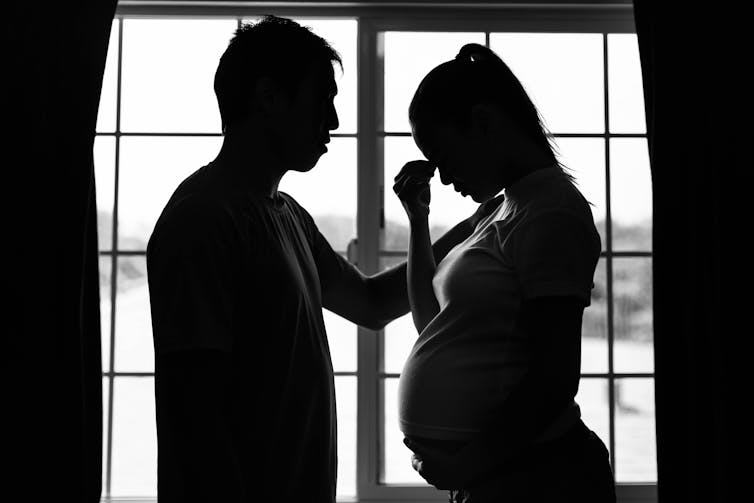The UK’s two-child limit on benefits is hurting the poorest families – poverty experts on why it should be abolished

Liderina/Shutterstock
Under the UK’s two-child limit, families on benefit receive a payment for each of their first two children, but no more for any additional children.
The limit results in families losing around £3,200 a year for any third or subsequent child born after April 2017. For low-income households, that’s a huge amount. The policy affects over 400,000 families, according to estimates by think tank the Resolution Foundation.
Our new research shows that larger families have become poorer since the introduction of the two-child limit – and the poorest families are losing out the most. The policy breaks the link between need and social benefits: rather than helping those in greatest need, the it punishes them.
The two-child limit came into force in April 2017. A family claiming working-age means-tested benefits, such as the child tax benefit, housing benefit, or universal credit, who had a third or subsequent child born after April 6 2017 does not receive a child related payment for them. Larger families with children born before this date continue to receive the standard child addition.
Research has found that the two-child limit, along with the benefit cap (an upper limit on the amount of out-of-work benefits a family can receive) has put larger families under enormous pressure and harmed parents’ mental health.
Another brutal detail is known as the “rape clause”. The two-child limit allows for an exception in the event of non-consensual conception, but it requires victims to provide third party evidence – such as a criminal injuries compensation scheme award – and prove they are not living with the perpetrator.
Losing out
Our new research used data from the Households Below Average Income dataset, a nationally representative source of information on household incomes. We compared data from 2015-16, before the two-child limit came into force, with 2019-20 (the pandemic disrupted later data collection). We also compared small families – those with one or two children – with larger families of three or more children.
We measured poverty using household disposable incomes after taxes and benefits, but before housing costs. Children in households with incomes below 60% of the national median were counted as poor.
When the two-child limit was announced in 2015, 27% of children in larger families lived in low-income households, based on this measure, compared with 17% of children in smaller families. By 2019-20, after the introduction of the two-child limit, the larger family poverty rate had gone up to 37%. It remained at 17% for smaller families. This was because larger families’ incomes fell rather than because poorer families had more children.
This cannot be solely attributed to the two-child limit. Poverty in larger families had been increasing before it was introduced. But it means that the limit penalised families that were already vulnerable.

The poorest families are losing out.
christinarosepix/Shutterstock
We also looked at income differences between larger families with or without a child under three. The two-child limit came into force in 2017, meaning that in 2019-20 larger families with children aged under three would be affected by the policy. We found that larger families with a child under three had lower incomes on average in real terms in 2019-20 than in 2015-16.
And we found that poverty has worsened the most in the poorest larger families. Between 2015-16 and 2019-20, the large families who were poorer than 90% of families nationally saw their income fall by 18% in real terms. The larger families on middling incomes saw their income fall by 9%.
The income of the poorest small families – families not affected by the two child limit – also fell in real terms, but by much less: 2%.
Unusual limits
From an international perspective, the UK two-child limit policy is unusual. None of the other developed countries that are members of the Organisation for Economic Co-operation and Development limit the number of children eligible for means-tested family benefits to two children, and in many countries benefits increase with family size.
Research from the London School of Economics shows that only three European Union countries restrict their benefits by family size (Cyprus, Romania and Spain) but they do so at three or four children.
The rationale for the two-child limit was to reduce government deficit, but it also sought to encourage parents “to reflect carefully on their readiness to support an additional child”.
The End Child Poverty Coalition argues that scrapping the limit would be the most cost effective way of reducing child poverty, stating that for the estimated cost of £1.3 billion, a quarter of a million children would be lifted from poverty. If the Labour party is serious about breakding down the barriers to opportunity, abolishing the two-child limit should be the first thing they do, should they come to power.
![]()
Jonathan Bradshaw receives funding from no one currently. He is a member of the Research Committee of the Child Poverty Action Group and an Emeritus Professor at the University of York..
Yekaterina Chzhen does not work for, consult, own shares in or receive funding from any company or organisation that would benefit from this article, and has disclosed no relevant affiliations beyond their academic appointment.







